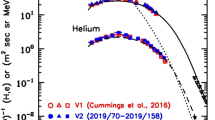Abstract
IT has been pointed out recently1 that the height of the atmospheric layer (100 mb.) in which most mesons are supposed to be produced decreases from the equator towards the poles. The decay of the mesons causes a corresponding increase in cosmic ray intensity.
Similar content being viewed by others
References
Kupferberg, K. M., Phys. Rev., 73, 804 (1948).
Rathgeber, H. D., Naturwiss., 26, 842 (1938).
Kohlhorster, W., and Matthes, I., Phys. Z., 40, 142 (1939).
Compton, A. H., and Turner, R. N., Phys. Rev., 52, 799 (1937).
Gill, P. S., Phys. Rev., 55, 1151 (1939).
Hann-Suring, "Lehrbuch der Meteorologie", 1, 259.
Haurwitz and Austin, "Climatology", 58 (1944).
Rossi, B., Hilberry, N., and Hoag, J. B., Phys. Rev., 57, 461 (1940).
Duperier, A., Terr. Mag. and Atmos. Elec., 49, 1 (1944).
Author information
Authors and Affiliations
Rights and permissions
About this article
Cite this article
RATHGEBER, H. Latitude Effect and Meson Decay. Nature 162, 303–304 (1948). https://doi.org/10.1038/162303b0
Issue Date:
DOI: https://doi.org/10.1038/162303b0
- Springer Nature Limited
This article is cited by
-
Latitude Effect and Pressure-Level of Meson Formation
Nature (1949)





